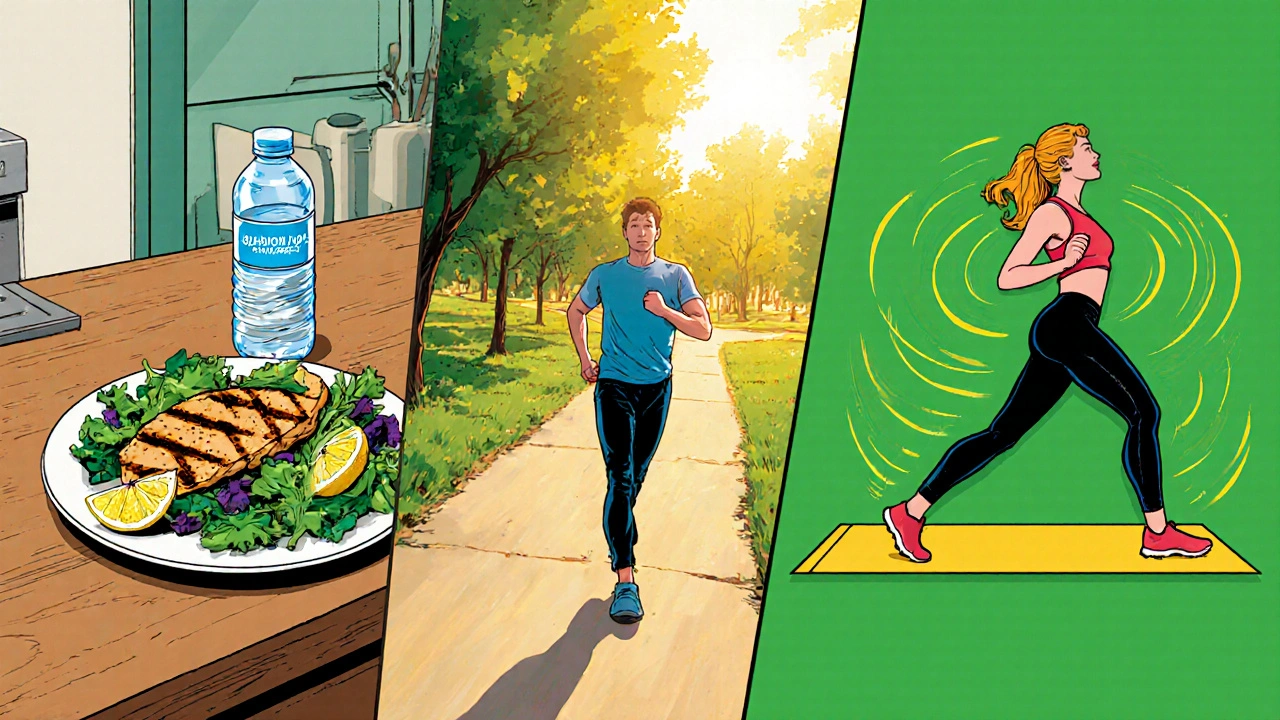Sodium Intake Calculator
Daily Sodium Tracker
Help manage abdominal fluid retention by tracking your sodium intake. Stay under 2,300 mg per day as recommended in the article.
- No items added yet 0 mg
Seeing your waistline expand overnight can be alarming, but the swelling isn’t always a sign of weight gain. It often points to abdominal fluid retention, a buildup of excess liquid in the belly cavity that can make you feel uncomfortable and restrict daily activities.
Quick Takeaways
- Identify common triggers: high‑salt meals, liver disease, heart failure, kidney problems.
- Adopt a low‑sodium diet (under 2,300mg per day) and stay hydrated with water, not sugary drinks.
- Incorporate gentle exercise like walking or yoga to stimulate circulation.
- Consider diuretics only under medical supervision; monitor potassium and blood pressure.
- Seek professional care if you notice rapid belly growth, pain, or shortness of breath.
What Is Abdominal Fluid Retention?
Abdominal fluid retention is the accumulation of fluid in the peritoneal cavity, the space that lines the abdomen. Doctors often refer to this condition as ascites. The fluid can stem from several medical issues, the most common being liver cirrhosis, congestive heart failure, or chronic kidney disease.
When the liver is scarred, it struggles to produce enough albumin, a protein that helps keep fluid inside blood vessels. Low albumin pressure pushes water into the abdomen. Similarly, a failing heart pumps blood less efficiently, raising pressure in veins that drain the belly, while kidney dysfunction reduces the body’s ability to excrete excess sodium and water.
Key Causes and Risk Factors
Understanding the root cause helps you pick the right strategy. Major contributors include:
- Liver disease - especially cirrhosis from alcohol or hepatitis.
- Heart failure - raises pressure in the portal vein.
- Kidney disease - limits sodium excretion.
- Low protein intake - reduces albumin levels.
- Excessive salt consumption - pulls water into the bloodstream.

Lifestyle Tweaks That Make a Difference
Before reaching for medication, try these evidence‑backed adjustments.
1. Low‑Sodium Eating Plan
Sodium is the chief driver of fluid retention. Aim for less than 2,300mg per day (about one teaspoon of salt). Replace salty snacks with fresh fruit, unsalted nuts, and herbs like rosemary or thyme for flavor.
Sample day:
- Breakfast - oatmeal with berries, a sprinkle of cinnamon, and a glass of water.
- Lunch - grilled chicken salad with mixed greens, cucumber, olive oil, and lemon juice.
- Snack - carrot sticks with hummus (make sure the hummus is low‑salt).
- Dinner - baked salmon, quinoa, steamed broccoli, and a side of roasted sweet potato.
2. Stay Hydrated, But Smartly
Drinking enough water helps kidneys flush excess sodium. Aim for 1.5-2L of plain water daily. Avoid sugary sodas and alcoholic drinks that can worsen dehydration and liver stress.
3. Gentle Physical Activity
Walking for 30 minutes a day or practicing a beginner yoga flow encourages lymphatic drainage and improves circulation. Avoid high‑impact workouts that raise intra‑abdominal pressure, which can temporarily worsen swelling.
4. Protein‑Rich Nutrition
Include lean protein sources (chicken, fish, legumes) to support albumin production. A typical adult needs about 0.8g of protein per kilogram of body weight per day.
5. Elevate and Support
When you’re sitting, place a small pillow under your knees to relieve pressure on the abdomen. If you have lower‑leg swelling, a compression garment can help move fluid back toward the heart.
Medical Options to Consider
If lifestyle changes aren’t enough, doctors may prescribe diuretics. These “water pills” signal kidneys to excrete more sodium and water.
- Spironolactone - often first‑line for ascites related to liver disease; it blocks aldosterone, a hormone that holds onto sodium.
- Furosemide - a loop diuretic used in heart failure; works faster but can deplete potassium.
Key monitoring points:
- Check potassium levels every 1-2weeks; low potassium can cause muscle cramps, while high potassium can affect heart rhythm.
- Track weight daily; a loss of 2-3pounds in a week usually indicates the diuretic is working.
- Watch blood pressure; aggressive diuresis can cause dizziness.
Never start or stop diuretics without a doctor’s order, as abrupt changes can trigger severe electrolyte imbalances.
Procedural Interventions
When fluid builds up quickly or causes breathing difficulty, a doctor may perform paracentesis. This minimally invasive procedure uses a thin needle to drain excess fluid, providing immediate relief.
After drainage, patients often receive albumin infusions to stabilize blood volume. Repeated paracentesis may indicate the need for more aggressive treatment, such as a transjugular intra‑hepatic portosystemic shunt (TIPS) for portal hypertension.

Home‑Based Support Techniques
Beyond diet and meds, a few simple practices can ease discomfort.
- Lymphatic drainage massage - light, rhythmic strokes directed toward the groin can move fluid out of the abdomen.
- Wear loose‑fitting clothing; tight waistbands compress the abdomen and hinder fluid movement.
- Practice deep breathing exercises; diaphragmatic breathing gently massages internal organs and promotes circulation.
Comparison of Management Strategies
| Aspect | Lifestyle Adjustments | Diuretic Therapy | Procedural Intervention |
|---|---|---|---|
| Speed of Relief | Days to weeks | Hours to days | Immediate (within minutes) |
| Typical Cost (UK) | £0-£50 (food, exercise) | £10-£30 per prescription | £1,200-£2,500 per procedure |
| Side‑Effect Risk | Low | Electrolyte imbalance, dizziness | Infection, bleeding |
| Long‑Term Sustainability | High when habits stick | Depends on underlying disease | Usually episodic |
| Best for | Mild‑to‑moderate swelling, early stage | Persistent edema despite diet, heart/liver disease | Acute abdominal distension, respiratory compromise |
Checklist: Daily Actions to Keep Fluid in Check
- Log sodium intake; keep it <2,300mg.
- Drink 1.5-2L water; avoid soda and alcohol.
- Take a 30‑minute walk or do a gentle yoga sequence.
- Consume 0.8g protein per kg body weight.
- Wear a loose waistband; consider compression socks if legs swell.
- Weigh yourself each morning; note any sudden gain >2lb.
- Check blood pressure and, if on diuretics, potassium levels as advised.
Frequently Asked Questions
Can a low‑salt diet cure abdominal fluid retention?
A low‑salt diet reduces the driving force behind fluid buildup, but it won’t fully resolve retention caused by liver, heart, or kidney disease. It’s a cornerstone of management, often combined with medication.
How much weight loss is expected when starting diuretics?
Most patients lose 2-3pounds in the first week. If you see a rapid drop (>5pounds) you should contact a doctor, as it may signal dehydration.
Is paracentesis dangerous?
When performed by an experienced clinician, paracentesis carries a low risk (about 1‑2% for infection or bleeding). Ultrasound guidance further reduces complications.
What role does albumin play in fluid retention?
Albumin maintains oncotic pressure, keeping water inside blood vessels. Low albumin levels, common in advanced liver disease, let fluid seep into the abdomen.
Can I manage ascites without medication?
Mild ascites may respond to strict salt restriction, fluid control, and daily activity. However, most cases eventually require diuretics or procedural drainage.

rachel mamuad
August 6, 2025
When tackling abdominal fluid retention, the first thing to calibrate is your sodium intake, because excess Na⁺ acts like a magnet for water in the interstial spaces.
A daily cap of 2,300 mg is the guideline most clinicians reference, but the real sweet spot often hovers near 1,500 mg for patients with cirrhotic ascites.
If you overshoot that threshold, the renal tubules struggle to excrete enough water, leading to a cascade of volume overload.
One practical hack is to log every packaged snack you touch, since processed foods typically slap on 200‑500 mg per serving without a warning label.
Many folks overlook hidden sodium in condiments, canned soups, and even certain breads, so a thorough label scan is non‑negotiabl.
Beyond diet, loop diuretics such as furosemide boost the Na⁺/K⁺ pump activity, pushing more salt and water out via the urine.
However, monotherapy often hits a diminishing returns wall, and adding a thiazide like spironolactone can create a synergistic diuretic effect.
Beware of electrolyte imbalances; aggressive sodium depletion can precipitate hyponatremia, which manifests as nausea, confusion, or even seizures.
If diuretics alone fail to tilt the balance, therapeutic paracentesisis-ultrasound‑guided needle drainage-offers a rapid decompression of the peritoneal cavity.
The procedure carries a low complication rate, roughly 1‑2 % for infection or bleeding, especially when performed by an experienced clinician.
Some practitioners also administer albumin intravenously after large‑volume paracentesis to sustain oncotic pressure and prevent post‑procedure hypotension.
Albumin works by maintaining colloid osmotic pressure, essentially keeping fluid tethered inside the vasculature rather than seeping into the abdomen.
Lifestyle tweaks like modest fluid restriction-no more than 1.5‑2 L per day-can complement dietary sodium cuts, though over‑restriction may trigger renal hypoperfusion.
Regular physical activity, even light walking, stimulates lymphatic return and helps mobilize interstitial fluid back into circulation.
Ultimately, a multimodal approach that synchronizes nutrition, pharmacology, and procedural options yields the best odds of keeping ascites at bay.
Amanda Anderson
August 6, 2025
Wow, I never realized how sneaky sodium can be.
Cutting back feels like battle, but the payoff-less belly swelling-is worth every grain I skip.
Carys Jones
August 6, 2025
Honestly, the whole “stay under 2,300 mg” mantra is a marketing ploy to scare health‑nutters.
Most healthy adults can tolerate a bit more sodium without turning into a water‑balloon.
If you’re not a liver‑failure patient, obsessing over milligrams is just anxiety‑fuel.
Roxanne Porter
August 6, 2025
I concur with the emphasis on comprehensive monitoring.
Incorporating a structured daily sodium log alongside routine weight measurements can facilitate early detection of fluid accrual.
Moreover, discussing diuretic titration with a hepatology specialist ensures individualized management.
Jonathan Mbulakey
August 6, 2025
Indeed, the interplay between renal excretion and portal hypertension warrants careful balance.
While diuretics are indispensable, their dosing must reflect renal function to avoid precipitating acute kidney injury.
Warren Neufeld
August 6, 2025
Just track your sodium and you’ll see progress.
Deborah Escobedo
August 6, 2025
Great tip on checking labels – it’s the easiest habit to adopt and makes a big difference
Dipankar Kumar Mitra
August 7, 2025
Listen, if you think a label glance is enough, you’re living in a simulation where reality hides in the fine print; true mastery demands you dissect every ingredient list like a philosopher deconstructing perception.
Tracy Daniels
August 7, 2025
Remember, consistency beats intensity – keep logging your intake daily, and you’ll build a reliable dataset to guide your choices 😊